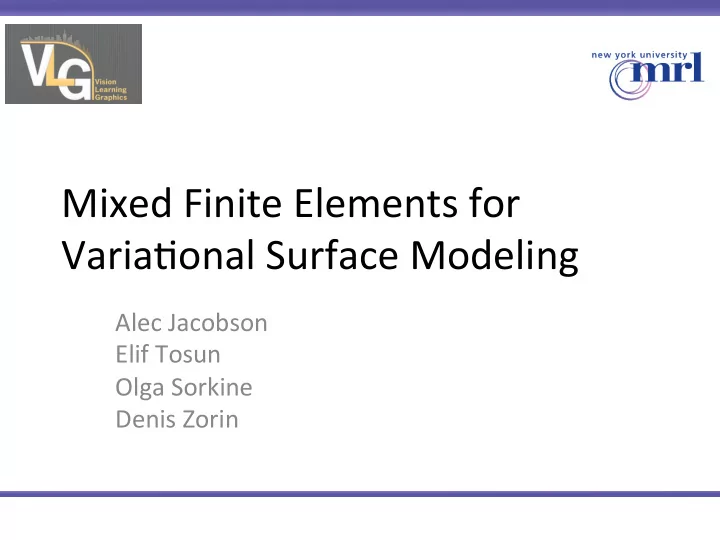

Mixed Finite Elements for Varia3onal Surface Modeling Alec Jacobson Elif Tosun Olga Sorkine Denis Zorin
Common goal is to obtain or maintain high‐quality surfaces Low‐quality surface High‐quality surface Original image: [Grinspun, Gingold, Reisman, and Zorin, 2006]
We’d like to be able to fill holes in exis3ng surfaces, … Also care about quality of boundary between new surface and old surface
… connect exis3ng surfaces, … Important that boundaries of different surfaces blend smoothly
… connect exis3ng curves, … High‐precision controls for high‐quality surfaces
… and edit exis3ng surfaces Fine‐tuned edits that preserve details
There are many ways to describe high quality surfaces NURBS Implicit Surfaces Original images: Wikipedia and [Bourke, 1997]
Solving a PDE turns surface modeling into boundary value problem PDE captures quality we would like, e.g.: PDE surface in con3nuous domain
Solving a PDE turns surface modeling into boundary value problem PDE captures quality we would like, e.g.: Find surface that sa3sfies PDE and boundary condi3ons PDE surface in con3nuous domain
Minimizing an energy or solving a PDE can produce high quality surfaces Discre3zed domain u i is the (x,y,z) posi3on of vertex i in discre3za3on mesh
Minimizing an energy or solving a PDE can produce high quality surfaces Discre3zed domain Define exterior and interior ( u Ω ) u i is the (x,y,z) posi3on of vertex i in discre3za3on mesh
Minimizing an energy or solving a PDE can produce high quality surfaces Discre3zed domain Define exterior and interior ( u Ω ) A u Ω = b u i is the (x,y,z) posi3on of vertex i in Solve for u Ω discre3za3on mesh
Designing a technique to discre3ze high order PDEs requires care Guarantees about surface quality: interior and boundary Expose control along boundary Posi3onal control of exterior Operate directly on input shape: simple triangle meshes, independent of discre3za3on Deriva3ve control at boundary
Must support different boundary types Points Curves Regions
We present a technique for discre3zing high order PDEs Doesn’t require high‐order elements Support points, curves and regions as boundaries Exposes tangent and curvature control Solu3on in single, sparse linear solve
We present a technique for discre3zing high order PDEs Doesn’t require high‐order elements Support points, curves and regions as boundaries Exposes deriva3ve and curvature control Solu3on in single, sparse linear solve Real‐3me modeling and deforma3on Convergence for high order PDEs
Biharmonic and Triharmonic equa3ons serve as running examples Nota3on: Biharmonic equa3on
Biharmonic and Triharmonic equa3ons serve as running examples Nota3on: Biharmonic equa3on Laplacian energy
Biharmonic and Triharmonic equa3ons serve as running examples Nota3on: Biharmonic equa3on Laplacian energy Triharmonic equa3on
Biharmonic and Triharmonic equa3ons serve as running examples Nota3on: Biharmonic equa3on Laplacian energy Triharmonic equa3on Laplacian gradient energy
Bi‐/Tri‐ harmonic equa3ons produce smooth surfaces and boundaries Soap film Thin plate Curvature varia3on minimizing C 0 at boundary C 1 at boundary C 2 at boundary Posi3onal control at +Tangent control at +Curvature control at boundary boundary boundary Original image: [Botsch and Kobbelt, 2004]
Previous works have limita3ons Simple domains, analy3c boundaries [Bloor and Wilson 1990] Model shaped minimiza3on of curvature varia3on energy [Moreton and Séquin 1992] Interpolate curve networks, local quadra3c fits and finite differences [Welch and Witkin 1994] Uniform‐weight discrete Laplacian [Taubin 1995] Cotangent‐weight discrete Laplacian [Pinkall and Polthier 1993], [Wardetzky et al. 2007], [Reuter et al. 2009]
We can show previous solu3ons are applica3ons of mixed FEM approach [Clarenz et al., 2004] – Willmore Flow (fourth‐order PDE) – Posi3ons and co‐normals on boundary [Botsch and Kobbelt, 2004] – Discre3za3on of k‐harmonic equa3ons Discrete boundary condi3ons found in these can be derived from con3nuous case Original images: [Clarenz et al., 2004] and [Botsch and Kobbelt, 2004]
Standard finite element method would require high‐order elements Need many more degrees of freedom Exis3ng high‐order representa3ons are neither prac3cal, nor popular Need low order, C 0 , workarounds: e.g. mixed FEM
Discrete Geometric Discre3za3on not easily connected to con3nuous case Idea is to define mesh analog of con3nuous geometric quan3ty E.g. Laplace‐Beltrami operator integrated over vertex area Used omen in geometric modeling
We introduce mixed finite elements for varia3onal surface modeling Introduce new variable to convert high‐order problem into two low‐ order problems Solve two problems simultaneously
We introduce mixed finite elements for varia3onal surface modeling Introduce new variable to convert high‐order problem into two low‐ order problems Solve two problems simultaneously New variable needs to be enforced as hard constraint
We use Lagrange mul3pliers to enforce the new variable
We use Lagrange mul3pliers to enforce the new variable (New variable: )
We use Lagrange mul3pliers to enforce the new variable (New variable: ) (Lagrange mul3plier: )
We use Lagrange mul3pliers to enforce the new variable (New variable: ) (Lagrange mul3plier: ) (Green’s Iden3ty)
Discre3ze each variable using piece‐ wise linear elements Hat func3on: i 1 0 j k 1 at vertex i, 0 at all other ver3ces Linearly interpolated across edges, faces of mesh
Take deriva3ves of energy to find minimum With respect to :
Take deriva3ves of energy to find minimum With respect to : With respect to :
Take deriva3ves of energy to find minimum With respect to : With respect to : With respect to :
Take deriva3ves of energy to find minimum With respect to : With respect to : With respect to :
Take deriva3ves of energy to find minimum With respect to : Lagrange mul3plier has disappeared With respect to :
Solve simultaneously as one big system Move known parts to right‐hand side Rewrite in block matrix form: Neumann matrix Discrete Laplacian Mass matrix
Solve simultaneously as one big system Move known terms to right‐hand side Rewrite in block matrix form: A u Ω = b
We can solve deforma3ons in real‐ 3me using pre‐factored matrix Point boundaries Curve boundaries with deriva3ves
Region boundaries are also derived from con3nuous case Use two rings of boundary instead of one ring with specified deriva3ves Resul3ng systems are similar, different right‐hand sides Helps simplify implementa3on to support all three boundary types
Recommend
More recommend